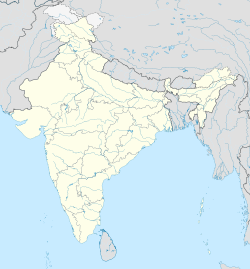Kashipur
| Kashipur | ||
|---|---|---|
|
|
||
| State : |
|
|
| State : | Uttarakhand | |
| District : | Udham Singh Nagar | |
| Sub-district : | Kashipur | |
| Location : | 29 ° 13 ′ N , 78 ° 58 ′ E | |
| Height : | 237 m | |
| Residents : | 121,623 (2011) | |
Kashipur ( Hindi काशीपुर, Kāśīpur) is a city in the Indian state of Uttarakhand . It is the largest city in the Udham Singh Nagar district and has a population of around 122,000 (2011 census).
history
Kashipur was at the time Harsha (606-647 n. Chr.), As Xuanzang visited the region (631-641) as Govishan known. The ruins of the large settlements from this period can still be seen near the city. Kashipur is named after Kashinath Adhikari, the founder of the community and one of the officials of the Chand rulers of Kumaon in the Middle Ages.
After the fall of the Harsha Empire, Kashipur became a forest area and was not repopulated until independence, when Prem Kapoor and Phiraya Lal Kapoor came to Kashipur as refugees from Pakistan in 1947 . You are among the few first known people to come to Kashipur when the area was densely forested. Today Kashipur is an important industrial location.
Infrastructure
Kashipur is approximately 225 kilometers from Delhi and more than 200 kilometers from Haridwar . It has good rail links to Ramnagar , Kathgodam , Muradabad , Bareli , Lucknow and Delhi. It is connected to all major cities in India and the region by road. Kashipur is on the national highway NH 74 . The nearest airport is 72 kilometers away at Pantnagar .
Culture
The poet Gumani wrote a poem about this city. Girital and Drona Sagar are well-known places and linked to the history of the Pandavas . The Chaiti mela is the most famous folk festival in Kashipur.
In autumn, after the monsoons , you can see the snow-capped peaks of Trishul and its surroundings.
Demographics
At the 2001 Indian census , Kashipur had a population of 92,978 people (52.6 percent male and 47.4 percent female). 14 percent of the population are children up to the age of six. The literacy rate is 67.9 percent (men 73.1 percent, women 62.1 percent) and is thus just above the national average of 64.8 percent. The most widely spoken languages are Hindi , Punjabi, and English .

